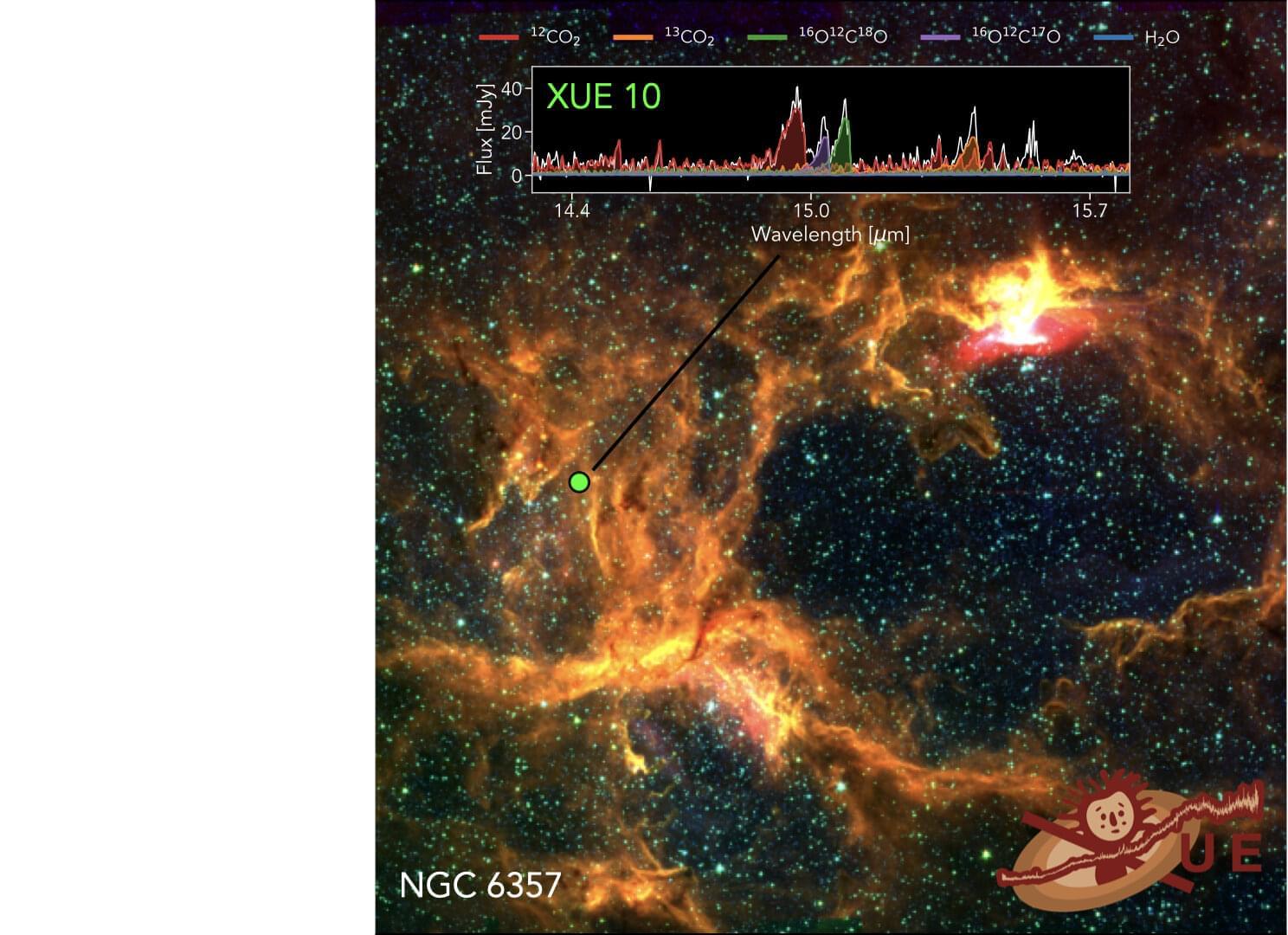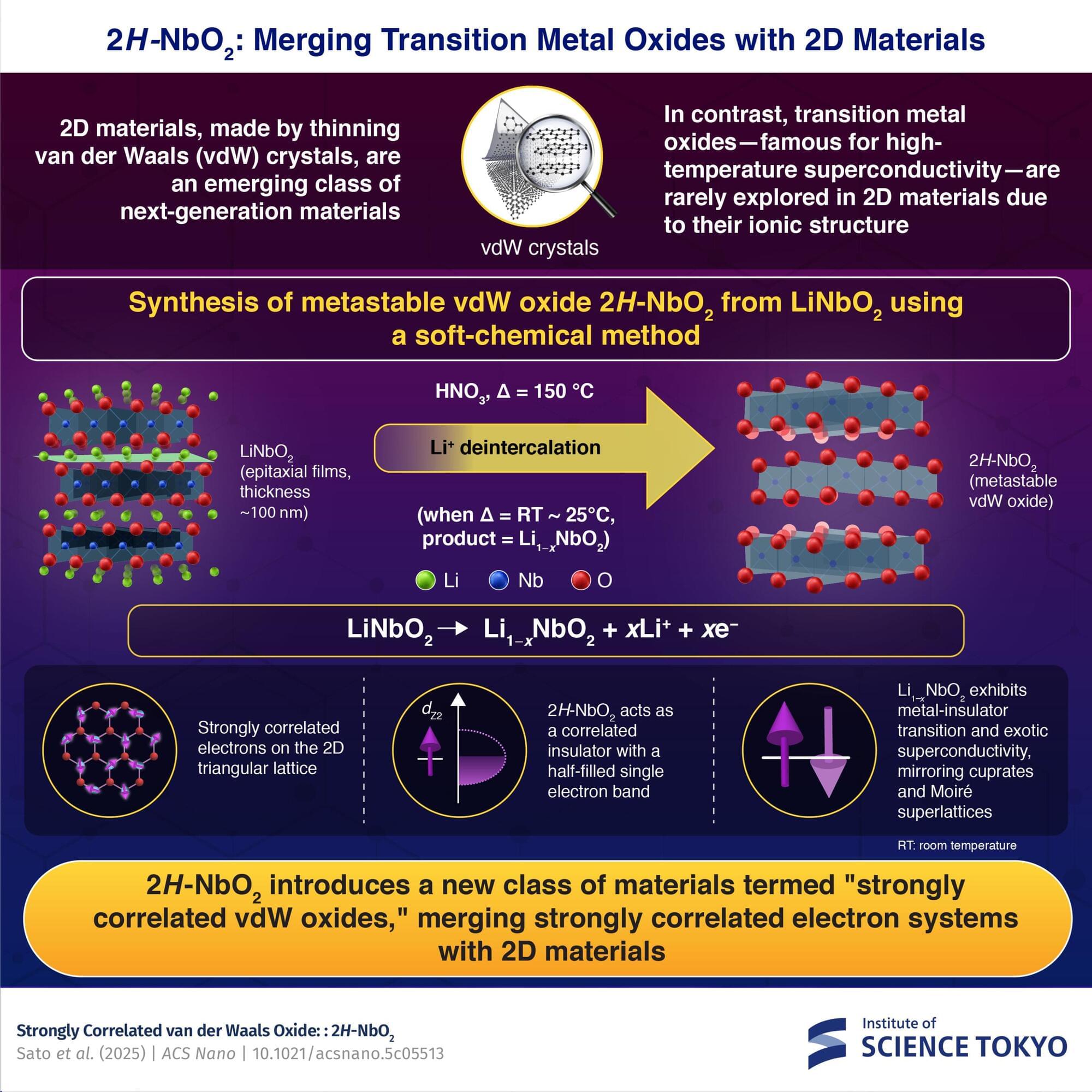A geological, petrographic and geochemical survey of distinctive mudstone and conglomerate outcrops of the Bright Angel formation on Mars reveals textures, chemical and mineral characteristics, and organic signatures that warrant consideration as potential biosignatures.
Category: chemistry – Page 33

Unusual CO₂-rich disk detected around young star challenges planet formation models
A study led by Jenny Frediani at Stockholm University has revealed a planet-forming disk with a strikingly unusual chemical composition: an unexpectedly high abundance of carbon dioxide (CO2) in regions where Earth-like planets may one day form.
The discovery, made using the James Webb Space Telescope (JWST), challenges long-standing assumptions about the chemistry of planetary birthplaces. The study is published in Astronomy & Astrophysics.
“Unlike most nearby planet-forming disks, where water vapor dominates the inner regions, this disk is surprisingly rich in carbon dioxide,” says Jenny Frediani, Ph.D. student at the Department of Astronomy, Stockholm University.



From layered transition metal oxide to 2D material: Scientists make 2H-NbO₂ discovery
2H-NbO₂—a novel van der Waals oxide synthesized by researchers from Japan—exhibits strongly correlated electronic properties with two-dimensional flexibility. By chemically extracting lithium ions from the layered sheets of LiNbO₂, the researchers transformed a three-dimensional oxide into a two-dimensional material—unlocking unique properties like Mott insulating states and superconductivity. Bridging transition metal oxides and 2D materials, the discovery paves the way for realizing advanced quantum materials in next-generation electronic devices.
Two-dimensional (2D) materials have become a cornerstone of next-generation electronic research. These materials—with their layers held together by weak van der Waals (vdW) forces—are celebrated for their unique quantum properties and promising applications in electronics. However, despite significant progress in 2D materials like graphene and transition metal dichalcogenides, one attractive family of materials called “transition metal oxides” or TMOs, remains unexplored for 2D application.
TMOs are a versatile class of materials known for their complex electronic properties like superconductivity, magnetism, and metal-insulator transitions. But due to their inherently strong ionic bonding, these oxides do not typically form vdW structures and therefore remain absent from 2D materials basically.
Modeling Electrochemistry with Continuum Non-Equilibrium Thermodynamics
Manuel Landstorfer — Modeling Electrochemistry with Continuum Non-Equilibrium Thermodynamics.
363 ‒ A new frontier in neurosurgery: brain-computer interfaces, new hope for brain diseases, & more
Edward Chang is a neurosurgeon, scientist, and a pioneering leader in functional neurosurgery and brain-computer interface technology, whose work spans the operating room, the research lab, and the engineering bench to restore speech and movement for patients who have lost these capabilities. In this episode, Edward explains the evolution of modern neurosurgery and its dramatic reduction in collateral damage, the experience of awake brain surgery, real-time mapping to protect critical functions, and the split-second decisions surgeons make. He also discusses breakthroughs in brain-computer interfaces and functional electrical stimulation systems, strategies for improving outcomes in glioblastoma, and his vision for slimmer, safer implants that could turn devastating conditions like ALS, spinal cord injury, and aggressive brain tumors into more manageable chronic illnesses.
View show notes here: https://bit.ly/46uJXlh.
Become a member to receive exclusive content: https://peterattiamd.com/subscribe/
Sign up to receive Peter’s email newsletter: https://peterattiamd.com/newsletter/
We discuss:
0:00:00 — Intro.
0:01:17 — The evolution of neurosurgery and the shift toward minimally invasive techniques.
0:10:58 — Glioblastomas: biology, current treatments, and emerging strategies to overcome its challenges.
0:17:39 — How brain mapping has advanced from preserving function during surgery to revealing how neurons encode language and cognition.
0:24:22 — How awake brain surgery is performed.
0:29:02 — How brain redundancy and plasticity allow some regions to be safely resected, the role of the corpus callosum in epilepsy surgery, and the clinical and philosophical implications of disconnecting the hemispheres.
0:43:46 — How neural engineering may restore lost functions in neurodegenerative disease, how thought mapping varies across individuals, and how sensory decline contributes to cognitive aging.
0:54:40 — Brain–computer interfaces explained: EEG vs. ECoG vs. single-cell electrodes and their trade-offs.
1:09:02 — Edward’s clinical trial using ECoG to restore speech to a stroke patient.
1:20:41 — How a stroke patient regained speech through brain–computer interfaces: training, AI decoding, and the path to scalable technology.
1:41:10 — Using brain-computer interfaces to restore breathing, movement, and broader function in ALS patients.
1:47:56 — The 2030 outlook for brain–computer interfaces.
1:52:35 — The potential of stem cell and cell-based therapies for regenerating lost brain function.
1:57:54 — Edward’s vision for how neurosurgery and treatments for glioblastoma, Parkinson’s disease, and Alzheimer’s disease may evolve by 2040
2:00:43 — The rare but dangerous risk of vertebral artery dissections from chiropractic neck adjustments and high-velocity movements.
2:02:31 — How Harvey Cushing might view modern neurosurgery, and how the field has shifted from damage avoidance to unlocking the brain’s functions.
——-
About:
The Peter Attia Drive is a deep-dive podcast focusing on maximizing longevity, and all that goes into that from physical to cognitive to emotional health. With over 90 million episodes downloaded, it features topics including exercise, nutritional biochemistry, cardiovascular disease, Alzheimer’s disease, cancer, mental health, and much more.
Peter Attia is the founder of Early Medical, a medical practice that applies the principles of Medicine 3.0 to patients with the goal of lengthening their lifespan and simultaneously improving their healthspan.

Gold-enhanced TiO₂ catalyst enables efficient and selective flow synthesis of propane from methane
Methane (CH₄), the colorless and odorless gas that makes up most natural gas on Earth, has so far been converted into useful fuels and chemicals via energy-intensive processes that need to be carried out at high temperatures. Some energy researchers, however, have been exploring the possibility of transforming this gas into useful hydrocarbons and chemicals via photocatalysis.
Photocatalysis is a process through which the energy contained in light, typically solar energy, activates a material known as a “catalyst,” driving desired chemical reactions. Converting CH₄ into specific fuels or chemicals via photocatalysis instead of conventional methods that rely on the burning of fossil fuels could be highly advantageous, as it could contribute to the reduction of greenhouse gas emissions.
Researchers at Hebei University and other institutes in China recently introduced a new photocatalysis-driven approach to convert CH₄ into propane (C₃H₈), a hydrocarbon that is easier to use in real-world settings, as it becomes liquid at specific pressures, which facilitates its storage and transport.

A new generative AI approach to predicting chemical reactions improves accuracy and reliability
Many attempts have been made to harness the power of new artificial intelligence and large language models (LLMs) to try to predict the outcomes of new chemical reactions. These have had limited success, in part because until now they have not been grounded in an understanding of fundamental physical principles, such as the laws of conservation of mass.
Now, a team of researchers at MIT has come up with a way of incorporating these physical constraints into a reaction prediction model, and thus greatly improving the accuracy and reliability of its outputs.
The new work is reported in the journal Nature, in a paper by recent postdoc Joonyoung Joung (now an assistant professor at Kookmin University, South Korea); former software engineer Mun Hong Fong (now at Duke University); chemical engineering graduate student Nicholas Casetti; postdoc Jordan Liles; physics undergraduate student Ne Dassanayake; and senior author Connor Coley, who is the Class of 1957 Career Development Professor in the MIT departments of Chemical Engineering and Electrical Engineering and Computer Science.

Fat microscopy to image lipids in cells
Lipid molecules, or fats, are crucial to all forms of life. Cells need lipids to build membranes, separate and organize biochemical reactions, store energy, and transmit information. Every cell can create thousands of different lipids, and when they are out of balance, metabolic and neurodegenerative diseases can arise. It is still not well understood how cells sort different types of lipids between cell organelles to maintain the composition of each membrane. A major reason is that lipids are difficult to study, since microscopy techniques to precisely trace their location inside cells have so far been missing.
The researchers developed a method that enables visualizing lipids in cells using standard fluorescence microscopy. After the first successful proof of concept, the authors brought mass-spectrometry expert on board to study how lipids are transported between cellular organelles.
“We started our project with synthesizing a set of minimally modified lipids that represent the main lipids present in organelle membranes. These modified lipids are essentially the same as their native counterparts, with just a few different atoms that allowed us to track them under the microscope,” explains a PhD student in the group.
The modified lipids mimic natural lipids and are “bifunctional,” which means they can be activated by UV light, causing the lipid to bind or crosslink with nearby proteins. The modified lipids were loaded in the membrane of living cells and, over time, transported into the membranes of organelles. The researchers worked with human cells in cell culture, such as bone or intestinal cells, as they are ideal for imaging.
“After the treatment with UV light, we were able to monitor the lipids with fluorescence microscopy and capture their location over time. This gave us a comprehensive picture of lipid exchange between cell membrane and organelle membranes,” concludes the author.
In order to understand the microscopy data, the team needed a custom image analysis pipeline. “To address our specific needs, I developed an image analysis pipeline with automated image segmentation assisted by artificial intelligence to quantify the lipid flow through the cellular organelle system,” says another author.
By combining the image analysis with mathematical modeling, the research team discovered that between 85% and 95% of the lipid transport between the membranes of cell organelles is organized by carrier proteins that move the lipids, rather than by vesicles. This non-vesicular transport is much more specific with regard to individual lipid species and their sorting to the different organelles in the cell. The researchers also found that the lipid transport by proteins is ten times faster than by vesicles. These results imply that the lipid compositions of organelle membranes are primarily maintained through fast, species-specific, non-vesicular lipid transport.